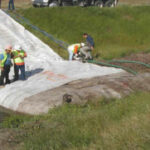
An 8' x 100' AquaDam® was used to block off this runoff channel so that a bridge crossing could be constructed immediately downstream. The AquaDam® was started at the top of the bank, rolled down to the flat area, and then crossed the lower portion of the channel. Water depth was only 18 inches.

The sides of this AquaDam® were folded in, and it spread apart as water pressure built inside. Notice that everybody seems to be standing around. On an installation like this, there is very little to do other than man the pumps.

Notice how high the AquaDam® was started up the bank, and how wide it is compared to the unrolled section. The AquaDam® was installed over the top of the grass, even though some brush was removed by hand.

The AquaDam® was still filling, but the pumping was put on hold because the canal had gone dry on the side the pumps were on. They were moved to the other side of the AquaDam®. The green grassy areas provide prime habitat for the California Red-Legged Frog, an endangered species.

Notice the white pipe extending out from the side of the bank. This will be used to pass the canal flow around the project area.

The AquaDam® eventually had to be filled using a tanker truck. The truck was already on site to water down the roads keeping dust to a minimum.

The AquaDam® was still filling. It takes a long time to fill an 8' high AquaDam® with trucked-in water. The water in front of the dam was only inches deep, so pumping was abandoned. The remainder of the filling was done by water trucks.
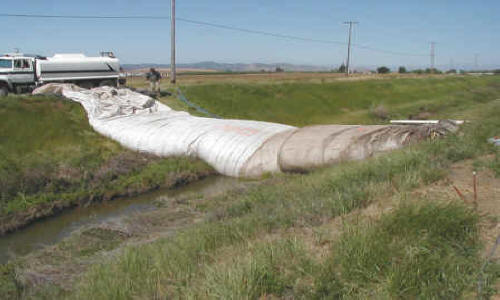
The AquaDam® was almost completely full. You can see how it conformed to the uneven channel of the canal.

On the downstream end of the construction site, a mound of washed gravel was placed across the canal so that water would percolate through it. A second AquaDam® was placed directly upstream from it.

A 4' high x 50' long AquaDam® was installed across the canal.

It fills in exactly the same way as the 8' high AquaDam®.

The used 4' high AquaDam® continued to fill.

The 4' AquaDam® was completely full. Water was being pumped out from underneath the bridge so that workers could get under it.
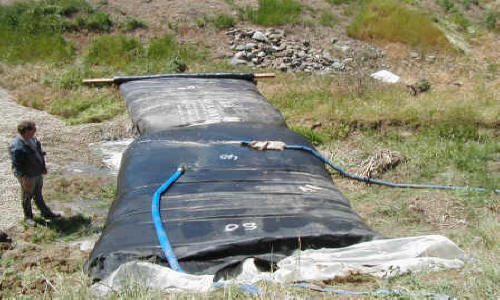
The discharged water is supposed to percolate through the gravel and go on downstream.

Looking upstream at the 8' high AquaDam® from underneath the four lane box-culvert bridge. This is the area that had to be dewatered, and new storm drainage line will intersect here underneath the highway.

Electric pumps were placed on the upstream side of the AquaDam® so that any release of water from upstream could be pumped up and around the work site. Nothing has been disturbed by the installation of the AquaDam®. Installation for this AquaDam® (even with trucking in water) was only 2.5 hours.

A view from upstream. The work area is the box culvert under the roadway.
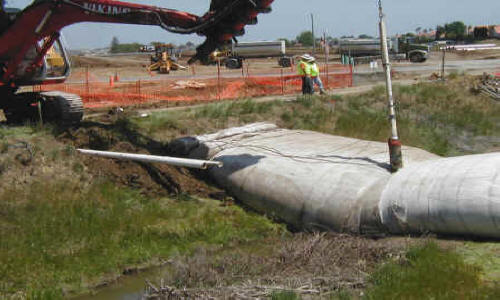
The idea is to hook the electric pump up to the white pipe, and whenever it rains, the pumps will kick on to divert the water around the work area.
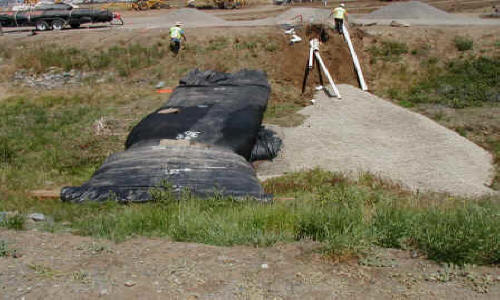
The downstream side. The water will be discharged between the gravel berm and the AquaDam®. There was no dirty water due to the clean installation of the AquaDams®. The whole project was started too early in the year (June). A late spring rainstorm (approximately 3/4") filled this channel up and washed out both AquaDams®. The bypass pumps had no chance of keeping up with the volume of water created by the rainstorm.


